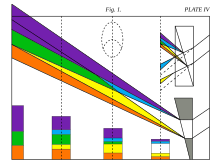| Author | Johann Wolfgang von Goethe |
|---|---|
| Original title | Zur Farbenlehre |
| Translator | Charles Eastlake[1] |
| Language | German |
| Publisher | John Murray |
Publication date | 1810 |
Published in English | 1840 |
| OCLC | 318274261 |

Theory of Colours (German: Zur Farbenlehre) is a book by Johann Wolfgang von Goethe about the poet's views on the nature of colours and how they are perceived by humans. It was published in German in 1810 and in English in 1840.[1] The book contains detailed descriptions of phenomena such as coloured shadows, refraction, and chromatic aberration. The book is a successor to two short essays titled "Contributions to Optics" (German: Beiträge zur Optik).
The work originated in Goethe's occupation with painting and primarily had its influence in the arts, with painters such as (Philipp Otto Runge, J. M. W. Turner, the Pre-Raphaelites, Hilma af Klint, and Wassily Kandinsky).
Although Goethe's work was rejected by some physicists, a number of philosophers and physicists have concerned themselves with it, including Thomas Johann Seebeck, Arthur Schopenhauer (see: On Vision and Colors), Hermann von Helmholtz, Ludwig Wittgenstein, Werner Heisenberg, Kurt Gödel, and Mitchell Feigenbaum.
Goethe's book provides a catalogue of how colour is perceived in a wide variety of circumstances, and considers Isaac Newton's observations to be special cases.[2] Unlike Newton, Goethe's concern was not so much with the analytic treatment of colour, as with the qualities of how phenomena are perceived. Philosophers have come to understand the distinction between the optical spectrum, as observed by Newton, and the phenomenon of human colour perception as presented by Goethe—a subject analyzed at length by Wittgenstein in his comments on Goethe's theory in Remarks on Colour and in Jonathan Westphal's Commentary on this work (1991).
- ^ a b Goethe's Theory of Colours: Translated from the German; with Notes by Charles Lock Eastlake, R.A., F.R.S. London: John Murray. 1840. Archived from the original on 12 December 2016. Retrieved 18 October 2017 – via Internet Archive.
- ^ Ribe, Neil; Steinle, Friedrich (July 2002). "Exploratory Experimentation: Goethe, Land, and Color Theory". Physics Today. 55 (7): 43–49. Bibcode:2002PhT....55g..43R. doi:10.1063/1.1506750.